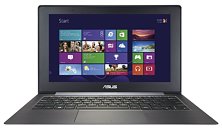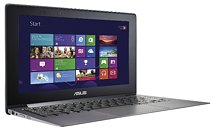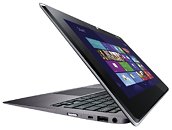Saturday, October 13th 2012

ASUS TAICHI 21 Dual-Display Convertible Notebook Up For Pre-Order
With two weeks to go until the official launch of Windows 8, ASUS has given the green light to pre-orders of its Win8-running TAICHI 21 convertible notebook featuring two 11.6-inch touchscreens. The back-to-back displays of the TAICHI 21 have an IPS panel, support up to 10-finger touch, and offer a maximum resolution of 1920 x 1080 pixels.
ASUS' multiple monitor mobile machine runs Windows 8 Home Premium (64-bit), is less than an inch thick, and also packs an Intel Core processor (a 1.7 GHz i5-3317U or 1.9 GHz i7-3517U), Intel GMA HD graphics, 4 GB of RAM, a 128/256 GB SSD, stereo speakers with Bang & Olufsen ICEpower technology, 802.11 b/g/n WiFi, Bluetooth 4.0, dual HD cameras, two USB 3.0 ports, and a 6-cell battery enabling up to 5 hours of operation.
The TAICHI 21-DH51 with a Core i5 CPU and a 128 GB SSD costs $1,300 while the 21-DH71 with a Core i7 chip and a 256 GB drive goes for $1,600.
ASUS' multiple monitor mobile machine runs Windows 8 Home Premium (64-bit), is less than an inch thick, and also packs an Intel Core processor (a 1.7 GHz i5-3317U or 1.9 GHz i7-3517U), Intel GMA HD graphics, 4 GB of RAM, a 128/256 GB SSD, stereo speakers with Bang & Olufsen ICEpower technology, 802.11 b/g/n WiFi, Bluetooth 4.0, dual HD cameras, two USB 3.0 ports, and a 6-cell battery enabling up to 5 hours of operation.
The TAICHI 21-DH51 with a Core i5 CPU and a 128 GB SSD costs $1,300 while the 21-DH71 with a Core i7 chip and a 256 GB drive goes for $1,600.



24 Comments on ASUS TAICHI 21 Dual-Display Convertible Notebook Up For Pre-Order
When Intel launched the ultrabook campaign to compete with apple's MacBooks, I, among others, was hoping that this meant we are going to get ultramobile laptops with specs better than those of MacBooks for comparable prices, or with comparable specs but with significantly lower prices. What is really happening with ASUS is neither this nor that. People might as well go and buy Apple's stuff. Other companies are taking better decisions in this regard IMO, Lenovo comes to mind.
Howeve, only time and sale figures will tell.
I blame AMD's lack of competition for the minor improvement ivy bridge offered over sandy bridge. :mad:
For example, remember the Mhz wars between Intel and AMD fighting to get to 1GHz first? I initially wanted to continue down the road of faster single core processors but as you know the industry eventually went in the direction of more efficient multi-core processors. I bought my first multi-core processor (AMD Athlon 64 X2 3800+) because it was powerful and reasonably priced despite having no specific need of more then one core at the time.
Now the direction Intel seems to be going in with Ivy Bridge is power efficiency. There likely would have been a more significant improvement with respect to the performance delta with Sandy Bridge had raw performance been the main objective. And we all know what happens when you significantly overclock Ivy Bridge, which, is step in the wrong direction for many here. Haswel and its successors will probably be no different in its objectives.
IMO its unfortunate that there is such a shift towards mobile computing. Portability is almost always more expensive in terms of performance (less performance per $) and the need for power efficiency further impedes performance.
The Asus Taichi is a nice design IMO but it comes off a little like a concept or of proof concept design rather then a retail product.
www.engadget.com/2012/06/04/asus-transformer-aio/
Great concept design IMO, not necessarily practical due to the size of the tablet though. Not totally unmanageable considering there are 17” laptops,….just no 18.4” tablets,…… ;)
Asus Transformer all-in-one hands-on - YouTube
I'm still rocking my 2011 MBA, there still hasn't been a mammoth leap in Ultrabooks, maybe next year we'll see something after Haswell ULV comes out.
I'm glad they made it though, even if it seems a bit unappealing to myself.